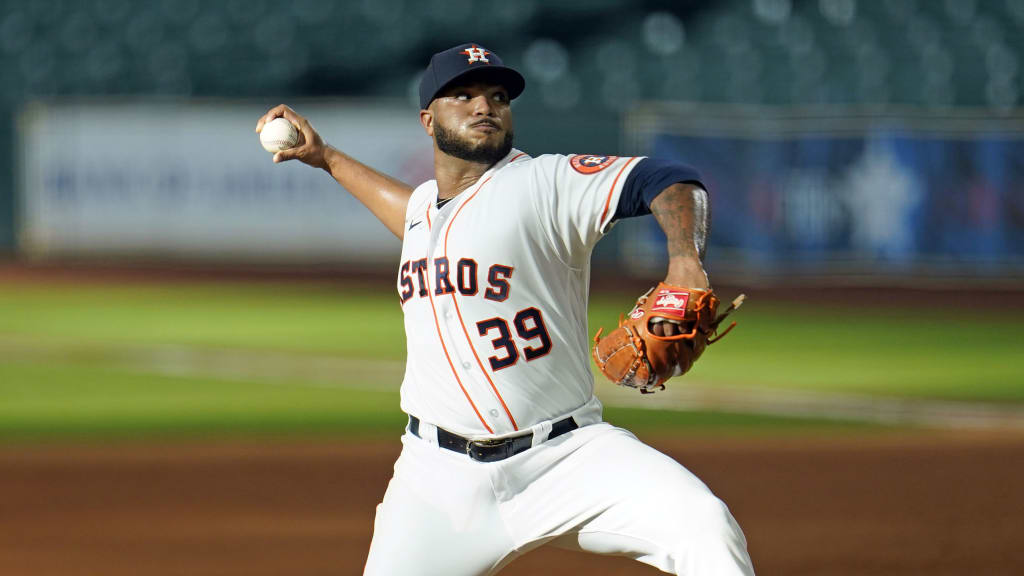
For most pitchers who work solely out of the bullpen, there isn’t a great need to have mastery of all four standard pitches. Many relievers’ repertoires consist of two or three, with the changeup often viewed as an added bonus if they can master it.
But for Astros right-hander Josh James, longer-term aspirations have given him reason to continue to be a four-pitch pitcher, even as he works out of the 'pen. James, who made two starts before he was assigned to the bullpen, has his eyes on the rotation and hopes someday -- even if it’s 2021 -- to reestablish himself as a starting pitcher. So for now, he’s hanging on to all of his weapons -- a fastball, slider, curveball and changeup -- with no immediate plans to alter his approach.
“I’m going to use them all, because I have higher hopes for next year,” he said. “I still want to try to be a starter again, so I want to keep the feel for all four pitches.”
James relies mostly on the four-seamer, which he’s thrown 59 percent of the time this year, and the slider (24 percent). The fastball, which has touched 100 mph, will always be James’ strongest weapon, and there has been a slight uptick in velocity on that pitch in his past two relief outings, prior to Monday’s opener with the Rockies at Minute Maid Park.
His average fastball velocity on Aug. 10 was 96.6 mph, and it was up to 97.5 mph on Aug. 15. As a starter, he averaged 95.5 mph.
Manager Dusty Baker said he has been encouraged by James’ performance since rejoining the bullpen, noting his uptick in velocity as time has progressed.
“I've seen guys go from the 'pen to a starter, and they tend to pace themselves,” Baker said. “They try to pace themselves into the fifth and sixth inning and consequently don't get out of the third or fourth. I think the fact that he’s in the bullpen, he can let it go, big time.”
James has always been good at that part. So far in 2020, he has a 34.9 percent whiff rate on all of his pitches, while the league average is 24.4 percent. That suits him well as a reliever, but James won’t be depending on blowing the fastball by hitters as his only way to navigate the later innings.
“I trust and believe in all four pitches that I have,” he said. “I don't think I need to narrow it down. I think having four will give me a little bit of an advantage, because it's going to be hard to cover all four. So I don't feel like I need to get rid of one just for short-term success, when I have a greater long-term goal.”
MRI for Alvarez
Yordan Alvarez’s ongoing knee issues continue to sideline him, and he was out of the lineup again for the opener with the Rockies. Alvarez underwent an MRI exam on his right knee, Baker said. The results were negative.
That doesn’t mean Alvarez is necessarily on the mend, however. The best the Astros can hope for in the short-term is possibly pinch-hitting duty, though there’s no guarantee he'll be available in that role, either.
“I asked him when did he start having these problems, and he said back in Double-A,” Baker said. “Most of the time when you have knee problems, they don’t subside very quickly. And when they do, they have a history of coming back.”
Rest when needed
With no fans in attendance at games so far this season, managers can manipulate the schedule a little more liberally when deciding when to rest star players. In normal times, managers are hesitant to give fan-favorites days off at home, which will undoubtedly disappoint some paying customers.
That’s not an issue this year. Baker is able to make decisions based solely on reports he receives from the training staff that show “red zones” -- indicating which players may be in danger of fatigue. That’s an area teams have had to pay closer attention to, given the short ramp up of Summer Camp that preceded the season.
“I like giving days off on the road, because you're kind of cheating your fans that come out that day to see their favorite player play,” Baker said. “But in our situation now, the fans aren't here. So you try to give guys days off when you see that they may need it.”
